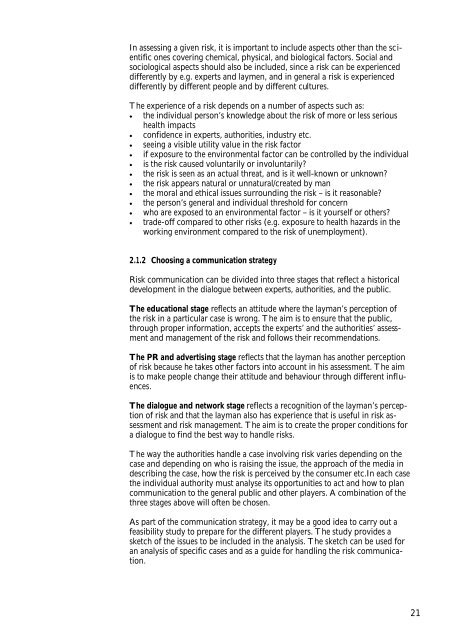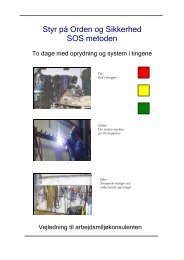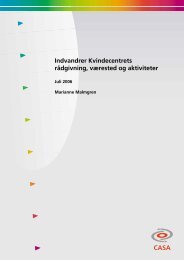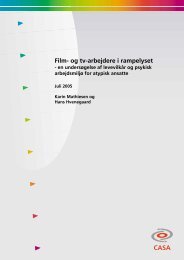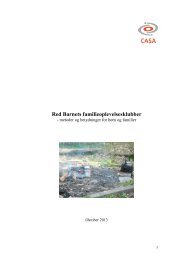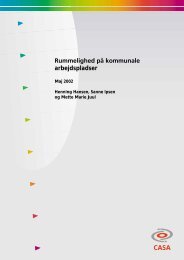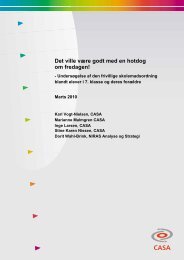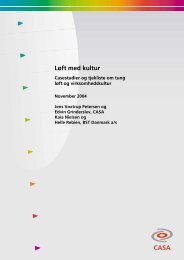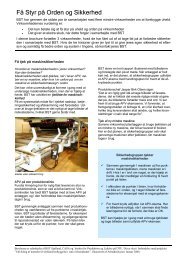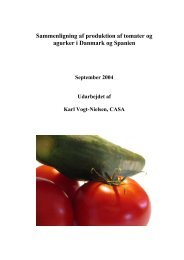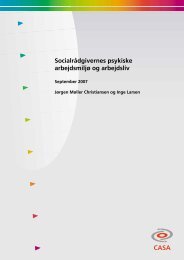Download rapport - Center for Alternativ Samfundsanalyse
Download rapport - Center for Alternativ Samfundsanalyse
Download rapport - Center for Alternativ Samfundsanalyse
You also want an ePaper? Increase the reach of your titles
YUMPU automatically turns print PDFs into web optimized ePapers that Google loves.
In assessing a given risk, it is important to include aspects other than the scientificones covering chemical, physical, and biological factors. Social andsociological aspects should also be included, since a risk can be experienceddifferently by e.g. experts and laymen, and in general a risk is experienceddifferently by different people and by different cultures.The experience of a risk depends on a number of aspects such as:• the individual person’s knowledge about the risk of more or less serioushealth impacts• confidence in experts, authorities, industry etc.• seeing a visible utility value in the risk factor• if exposure to the environmental factor can be controlled by the individual• is the risk caused voluntarily or involuntarily?• the risk is seen as an actual threat, and is it well-known or unknown?• the risk appears natural or unnatural/created by man• the moral and ethical issues surrounding the risk – is it reasonable?• the person’s general and individual threshold <strong>for</strong> concern• who are exposed to an environmental factor – is it yourself or others?• trade-off compared to other risks (e.g. exposure to health hazards in theworking environment compared to the risk of unemployment).2.1.2 Choosing a communication strategyRisk communication can be divided into three stages that reflect a historicaldevelopment in the dialogue between experts, authorities, and the public.The educational stage reflects an attitude where the layman’s perception ofthe risk in a particular case is wrong. The aim is to ensure that the public,through proper in<strong>for</strong>mation, accepts the experts’ and the authorities’ assessmentand management of the risk and follows their recommendations.The PR and advertising stage reflects that the layman has another perceptionof risk because he takes other factors into account in his assessment. The aimis to make people change their attitude and behaviour through different influences.The dialogue and network stage reflects a recognition of the layman’s perceptionof risk and that the layman also has experience that is useful in risk assessmentand risk management. The aim is to create the proper conditions <strong>for</strong>a dialogue to find the best way to handle risks.The way the authorities handle a case involving risk varies depending on thecase and depending on who is raising the issue, the approach of the media indescribing the case, how the risk is perceived by the consumer etc.In each casethe individual authority must analyse its opportunities to act and how to plancommunication to the general public and other players. A combination of thethree stages above will often be chosen.As part of the communication strategy, it may be a good idea to carry out afeasibility study to prepare <strong>for</strong> the different players. The study provides asketch of the issues to be included in the analysis. The sketch can be used <strong>for</strong>an analysis of specific cases and as a guide <strong>for</strong> handling the risk communication.21


